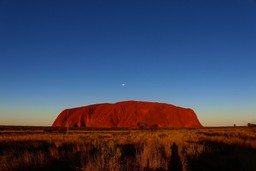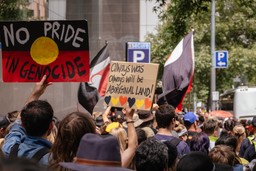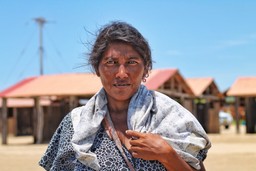Indigenous plant medicine traditions are part of Indigenous wisdom traditions across the world and are becoming central to questions of equity, justice, and healing in psychedelics. Bianca Sebben, PhD is a trauma-focused psychologist in Australia, is an ally and advocate for Indigenous-led healing spaces and a listener to – and a learner from – Indigenous people. Join Dr. Sebben as we learn about her work co-creating culturally-safe healing spaces with Indigenous leaders, and her practice of healing trauma with her own clients.
Getting to Know Dr. Bianca Sebben, PhD
Dr. Bianca Sebben is a psychologist based in Brisbane, Queensland, Australia with a special interest in complex trauma, dissociation and working with Aboriginal and Torres Strait Islander peoples. Dr. Sebben’s interest in psychedelics began when she was in Mexico completing her PhD in Indigenous Psychology, where she became interested in traditional methods of healing, including plant medicines, and the need to facilitate access to traditional methods of healing to make the medical system more culturally safe and accessible.
Her journey towards becoming a psychologist required her to step into a place of vulnerability, to practice compassion for all parts of the self and to honor and accept her own authenticity. She endeavors to support her clients to do the same, so that they can live harmoniously with a more integrated sense of self.
Connecting with Indigenous Plant Medicine Traditions & Indigenous Psychology
Dr. Sebben first engaged with plant medicines when she began working with Indigenous people in Australia 13 years ago. “Then, I completed my PhD in Mexico, which I finished in about 2016. I was working in a hostel in Mexico City that had Indigenous peoples from all over Mexico come to stay there so they could access medical services in tertiary hospitals.
The hostel also provided a safe space as well for the incorporation of traditional healing practices. So, I got to learn more about various cultural experiences of health and mental health and how various plant medicines could support healing.”
But then, working with Indigenous communities, it really expanded my idea of what well-being consists of. So, looking at the social, the emotional, the physical, the environmental, and the spiritual components of well-being and how connected we are to ourselves and each other and the natural environment.
“I also have a dear friend in Mexico who’s always happy for me to share their story. They were very depressed for a long time, suffering from fibromyalgia. I started to notice that their mood really improved, and they were making really good lifestyle changes and they were succeeding a lot in their personal and work life.
Follow your Curiosity
Sign up to receive our free psychedelic courses, 45 page eBook, and special offers delivered to your inbox.And I turned around and asked, ‘What’s changed? What’s different?’ They just go, ‘Can I tell you something? I smoked the toad.’ ‘And I was like, what’s this toad you speak of?’ So then, I began to research more and look into the healing potential of psychedelic medicines and that’s where it all began.”
One key learning from Dr. Sebben’s PhD in Indigenous psychology was an understanding of the role connection plays in healing. “In more recent years, psychology has been dominated by cognitive therapies. That was certainly the main component of my early training as a psychologist.
But then, working with Indigenous communities, it really expanded my idea of what well-being consists of. So, looking at the social, the emotional, the physical, the environmental, and the spiritual components of well-being and how connected we are to ourselves and each other and the natural environment.
So that’s certainly influenced my work as a trauma psychologist. And I now truly believe that an integral part of healing trauma is connection and a sense of belonging. That’s connection to ourselves, the world around us, our relationship with the natural environment, our relationship with each other, rather than this more Western individualistic view that really only focuses on the individual in an individual’s healing journey.”
…we definitely need to make sure that this isn’t about appropriating traditional practices, but more about making this treatment culturally safe and accessible for Indigenous peoples. That there are ongoing reparations for Indigenous peoples in recognition of the impact of the ancestral trauma they’ve experienced as well as the ongoing present-day impact that we’re seeing on Indigenous communities due to the increasing popularity of Indigenous plant medicine traditions.
Justice & Incorporating Indigenous Plant Medicine Traditions
Dr. Sebben actively engages with the challenging question of how and why Indigenous medicine practices are being incorporated into psychedelic practice. “As psychedelic psychotherapy is becoming more mainstream, we definitely need to make sure that this isn’t about appropriating traditional practices, but more about making this treatment culturally safe and accessible for Indigenous peoples. That there are ongoing reparations for Indigenous peoples in recognition of the impact of the ancestral trauma they’ve experienced as well as the ongoing present-day impact that we’re seeing on Indigenous communities due to the increasing popularity of Indigenous plant medicine traditions.
We’re all aware of what happened with Maria Sabina in her community when Western society became privy to the Mazatec mushroom tradition. So, I think reparations here are really essential, and then we can look more towards reciprocity rather than just taking this sacred knowledge and ways of healing and embedding it into a Western clinical model. Incorporating traditional medicine practices has to be about making this treatment safe and accessible to Indigenous peoples that may wish to access psychedelic medicines in this way.”
“I’m more thinking about the Australian context, as there’s not a lot of documented evidence of the use of psychedelic medicines. However, we do know that there are numerous psychoactive plants and fungi that have been utilized by Indigenous peoples here for over 50,000 years, as the oldest living culture in the world. Indigenous cultures here in Australia are typically a spoken culture and knowledge is passed down through the generations in the spoken manner to the people that are to be the recipients of that knowledge.
That knowledge, therefore, is very sacred and very protected and only passed down to those people that are in line to receive that knowledge. And we need to respect that that knowledge needs to remain as protected as it is, particularly given the impact of colonization and the significant impact this has had on that knowledge being able to be passed down through the generations.
In saying that, some of my early discussions about what traditional practices would be incorporated here include things like ceremony and community healing, rather than the typical one-on-one therapy session that we see in current psychedelic-assisted psychotherapy models, since healing typically happens in community and with community.”
So, I think reparations here are really essential, and then we can look more towards reciprocity rather than just taking this sacred knowledge and ways of healing and embedding it into a Western clinical model. Incorporating traditional medicine practices has to be about making this treatment safe and accessible to Indigenous peoples that may wish to access psychedelic medicines in this way.”
“We know these Indigenous plant medicine traditions are very relational in their healing. And we’re looking at the collective benefit of healing, rather than just the benefit for the individual. So, the benefit of incorporating ceremony in community is that it would establish a community base of support for the ongoing integration process as well. I’m currently working with the members of various Indigenous communities here in Australia to look at developing a culturally-safe model of psychedelic-assisted psychotherapy.”
As a note from Psychedelic Support, the Riverstyx Foundation works to advance Indigenous sovereignty and conserve Indigenous plant medicine traditions under the leadership of Indigenous communities. The Indigenous Peyote Conservation Initiative is an Indigenous-led effort empowering Indigenous communities to reconnect with, regenerate, and conserve their sacred Peyote medicine. The Indigenous Medicine Conservation Fund is vehicle that can do benefit sharing.
As Miriam Volat, director of the Riverstyx Foundation, shared in our recent Quick Trip interview: “This is creating an opportunity where funding from the West could meet Indigenous communities on the ground and really create a trusted partnership to ensure that these cultures, ceremonies, languages, and ecological relationships are not again lost like they were with the Mazatec.”
And we need to respect that that knowledge needs to remain as protected as it is, particularly given the impact of colonization and the significant impact this has had on that knowledge being able to be passed down through the generations.
Equity-Building & the Role of the Learner
Dr. Sebben continues to take the role of listener and learner in following Indigenous leadership in engaging with traditional medicine practices and connecting these practices with Western mental health processes.
“This is an ongoing learning experience for me. I think it’s about knowing the support that I can provide, or that we can provide as non-Indigenous practitioners, and where that support can and does have its place. But also working with Indigenous peoples at the same time as healers, therapists, and cultural consultants. I’ve typically always worked with a cultural consultant in some shape or form.
Working with people that have that knowledge and have the ability to work in a cultural way with clients and knowing our limitations in that as well. So, we are working together to best meet the needs of community or the client in the psychedelic-assisted psychotherapy context.”
“This is an ongoing learning experience for me. I think it’s about knowing the support that I can provide, or that we can provide as non-Indigenous practitioners, and where that support can and does have its place. But also working with Indigenous peoples at the same time as healers, therapists, and cultural consultants.
“But I really think the biggest thing I’ve learned over the years is to shut up and listen and to stay in my lane. I’m certainly take that into account while working on building this model as well. I know my place in bringing people together and [offering] some of the knowledge of Western psychotherapy practices, but
I’m also incredibly aware that there are going to be limitations to my involvement and even conversations that I won’t be able to be privy to. It really is just respecting that and knowing my place and where that starts and where that ends as well. Really to make sure that the right supports are available for the client and acknowledging where that might not be something that I can provide as a non-Indigenous.”
Modalities for Healing Trauma
“Personally, I think the most useful modalities for healing trauma [address] the social, the emotional, the physical, the spiritual, and the environmental aspects of healing. So, I have a preference for more somatic-focused therapies, as well as parts work modalities. I typically work with people with complex trauma and dissociative disorders.
So, I tend to start with more of a stabilization focus informed by polyvagal theory, learning how to regulate the nervous system, and wellbeing practices as well, such as trauma-sensitive yoga or embodied movement practices, to get a degree of stabilization happening first. I also find parts work modalities, such as therapies for the structural dissociation of the personality, or ego state therapy, internal family systems, therapies that look at the multiplicity of the internal system, are very beneficial to be working towards a more integrated sense of self…”
“I’m also an EMDR therapist as well. I find this a very beneficial treatment for supporting people to reprocess traumatic material. The meaning they make behind their trauma experiences, such as going from, ‘Something terrible happened to me because I’m a bad person.’ to more a sense of, ‘Something terrible happened to me because the other person was not a good person.’ T
he meaning making that comes from that more complex trauma, which is our early attachment system and the relationships we have, and that goes on to foster our sense of self and our self-concept over the years. I use EMDR quite a bit when supporting people in the integration of their experiences with non-ordinary states as well. I think it’s really important to look at the community supports that are in place as well, to really help foster that sense of connection and belonging in that healing journey.”
Healing Takes Time
Dr. Sebben shares some wisdom for people interested in healing and integration. “My first piece of advice is that healing from trauma is more of a marathon, rather than a sprint. It does take time to reprogram the nervous system and to get those parts of us that have had to act very protectively over the years to recognize the resources we have in the present, or the stability or the safety that we have in the present, and being able to unburden [those parts of us] from their roles a bit.
They don’t have to work so hard anymore in the present day that maybe they had to do in the time of trauma. That can and does take time and we have to have the utmost respect for how the system has helped us to survive over years or decades even.”
It does take time to reprogram the nervous system and to get those parts of us that have had to act very protectively over the years to recognize the resources we have in the present, or the stability or the safety that we have in the present, and being able to unburden [those parts of us] from their roles a bit.
“This really does take some time and commitment, so having adequate support in place is absolutely essential. I would really encourage people to reach out and seek support from qualified therapists and practitioners, because I do believe that we heal together in community and it’s incredibly difficult to do this work on your own without support.
Particularly when there is that early life attachment trauma, it can be very daunting to reach out and seek connection, because that can be the thing that we most fear or has been the place of most vulnerability for us as well. [I recommend] reaching out to a therapist that does understand the nature of trauma and early life attachment wounds. It’s a very worthwhile investment of somebody’s time as they start this journey of building safety and connection in their present-day experience.”
Connecting with Dr. Sebben
Dr. Sebben would love to connect with you through her website, consciousinsights.com.au. Her contact details can be found there along with an online form, which you can fill out to contact her directly.








